Research Proposal: Six Factors Influencing Housing Prices in Australia
VerifiedAdded on 2021/04/17
|5
|1263
|31
Project
AI Summary
This research proposal investigates the factors contributing to the rise in housing prices in Australia. It identifies the problem of increasing dwelling prices, attributing them to demographic changes and population growth, alongside economic and institutional influences. The research aims to understand the impact of various factors on housing prices, including immigration, and to evaluate the effects on Australian households and the economy. The methodology involves qualitative research, including literature reviews, data collection from governmental resources and interviews with stakeholders. Data analysis will be conducted using data from the Real Estate Institute of Australia (REIA) and the Reserve Bank of Australia (RBA) to analyze how different factors contribute to the growth in house prices, with the goal of informing future strategies for market growth and addressing affordability concerns.
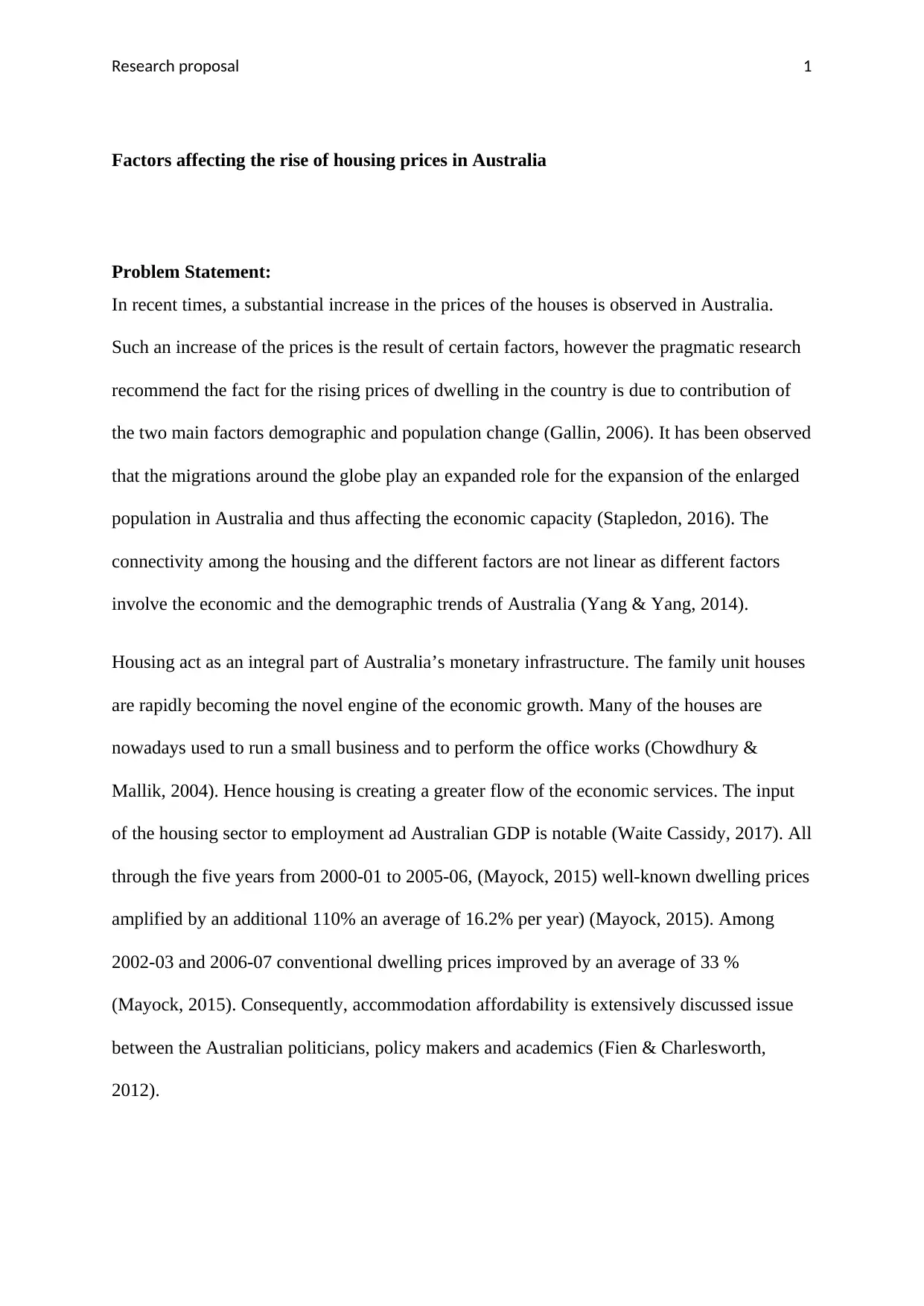
Research proposal 1
Factors affecting the rise of housing prices in Australia
Problem Statement:
In recent times, a substantial increase in the prices of the houses is observed in Australia.
Such an increase of the prices is the result of certain factors, however the pragmatic research
recommend the fact for the rising prices of dwelling in the country is due to contribution of
the two main factors demographic and population change (Gallin, 2006). It has been observed
that the migrations around the globe play an expanded role for the expansion of the enlarged
population in Australia and thus affecting the economic capacity (Stapledon, 2016). The
connectivity among the housing and the different factors are not linear as different factors
involve the economic and the demographic trends of Australia (Yang & Yang, 2014).
Housing act as an integral part of Australia’s monetary infrastructure. The family unit houses
are rapidly becoming the novel engine of the economic growth. Many of the houses are
nowadays used to run a small business and to perform the office works (Chowdhury &
Mallik, 2004). Hence housing is creating a greater flow of the economic services. The input
of the housing sector to employment ad Australian GDP is notable (Waite Cassidy, 2017). All
through the five years from 2000-01 to 2005-06, (Mayock, 2015) well-known dwelling prices
amplified by an additional 110% an average of 16.2% per year) (Mayock, 2015). Among
2002-03 and 2006-07 conventional dwelling prices improved by an average of 33 %
(Mayock, 2015). Consequently, accommodation affordability is extensively discussed issue
between the Australian politicians, policy makers and academics (Fien & Charlesworth,
2012).
Factors affecting the rise of housing prices in Australia
Problem Statement:
In recent times, a substantial increase in the prices of the houses is observed in Australia.
Such an increase of the prices is the result of certain factors, however the pragmatic research
recommend the fact for the rising prices of dwelling in the country is due to contribution of
the two main factors demographic and population change (Gallin, 2006). It has been observed
that the migrations around the globe play an expanded role for the expansion of the enlarged
population in Australia and thus affecting the economic capacity (Stapledon, 2016). The
connectivity among the housing and the different factors are not linear as different factors
involve the economic and the demographic trends of Australia (Yang & Yang, 2014).
Housing act as an integral part of Australia’s monetary infrastructure. The family unit houses
are rapidly becoming the novel engine of the economic growth. Many of the houses are
nowadays used to run a small business and to perform the office works (Chowdhury &
Mallik, 2004). Hence housing is creating a greater flow of the economic services. The input
of the housing sector to employment ad Australian GDP is notable (Waite Cassidy, 2017). All
through the five years from 2000-01 to 2005-06, (Mayock, 2015) well-known dwelling prices
amplified by an additional 110% an average of 16.2% per year) (Mayock, 2015). Among
2002-03 and 2006-07 conventional dwelling prices improved by an average of 33 %
(Mayock, 2015). Consequently, accommodation affordability is extensively discussed issue
between the Australian politicians, policy makers and academics (Fien & Charlesworth,
2012).
Paraphrase This Document
Need a fresh take? Get an instant paraphrase of this document with our AI Paraphraser
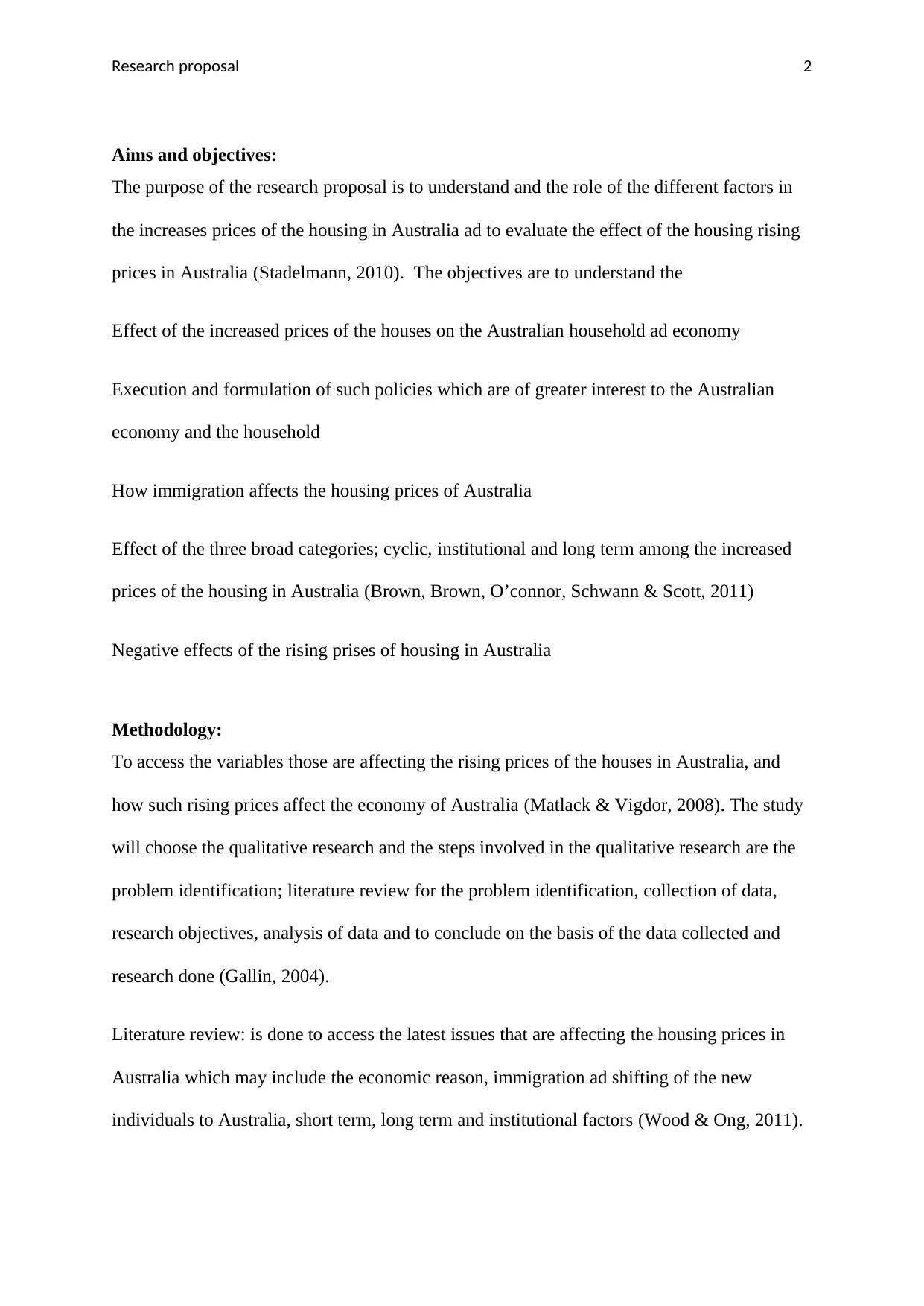
Research proposal 2
Aims and objectives:
The purpose of the research proposal is to understand and the role of the different factors in
the increases prices of the housing in Australia ad to evaluate the effect of the housing rising
prices in Australia (Stadelmann, 2010). The objectives are to understand the
Effect of the increased prices of the houses on the Australian household ad economy
Execution and formulation of such policies which are of greater interest to the Australian
economy and the household
How immigration affects the housing prices of Australia
Effect of the three broad categories; cyclic, institutional and long term among the increased
prices of the housing in Australia (Brown, Brown, O’connor, Schwann & Scott, 2011)
Negative effects of the rising prises of housing in Australia
Methodology:
To access the variables those are affecting the rising prices of the houses in Australia, and
how such rising prices affect the economy of Australia (Matlack & Vigdor, 2008). The study
will choose the qualitative research and the steps involved in the qualitative research are the
problem identification; literature review for the problem identification, collection of data,
research objectives, analysis of data and to conclude on the basis of the data collected and
research done (Gallin, 2004).
Literature review: is done to access the latest issues that are affecting the housing prices in
Australia which may include the economic reason, immigration ad shifting of the new
individuals to Australia, short term, long term and institutional factors (Wood & Ong, 2011).
Aims and objectives:
The purpose of the research proposal is to understand and the role of the different factors in
the increases prices of the housing in Australia ad to evaluate the effect of the housing rising
prices in Australia (Stadelmann, 2010). The objectives are to understand the
Effect of the increased prices of the houses on the Australian household ad economy
Execution and formulation of such policies which are of greater interest to the Australian
economy and the household
How immigration affects the housing prices of Australia
Effect of the three broad categories; cyclic, institutional and long term among the increased
prices of the housing in Australia (Brown, Brown, O’connor, Schwann & Scott, 2011)
Negative effects of the rising prises of housing in Australia
Methodology:
To access the variables those are affecting the rising prices of the houses in Australia, and
how such rising prices affect the economy of Australia (Matlack & Vigdor, 2008). The study
will choose the qualitative research and the steps involved in the qualitative research are the
problem identification; literature review for the problem identification, collection of data,
research objectives, analysis of data and to conclude on the basis of the data collected and
research done (Gallin, 2004).
Literature review: is done to access the latest issues that are affecting the housing prices in
Australia which may include the economic reason, immigration ad shifting of the new
individuals to Australia, short term, long term and institutional factors (Wood & Ong, 2011).
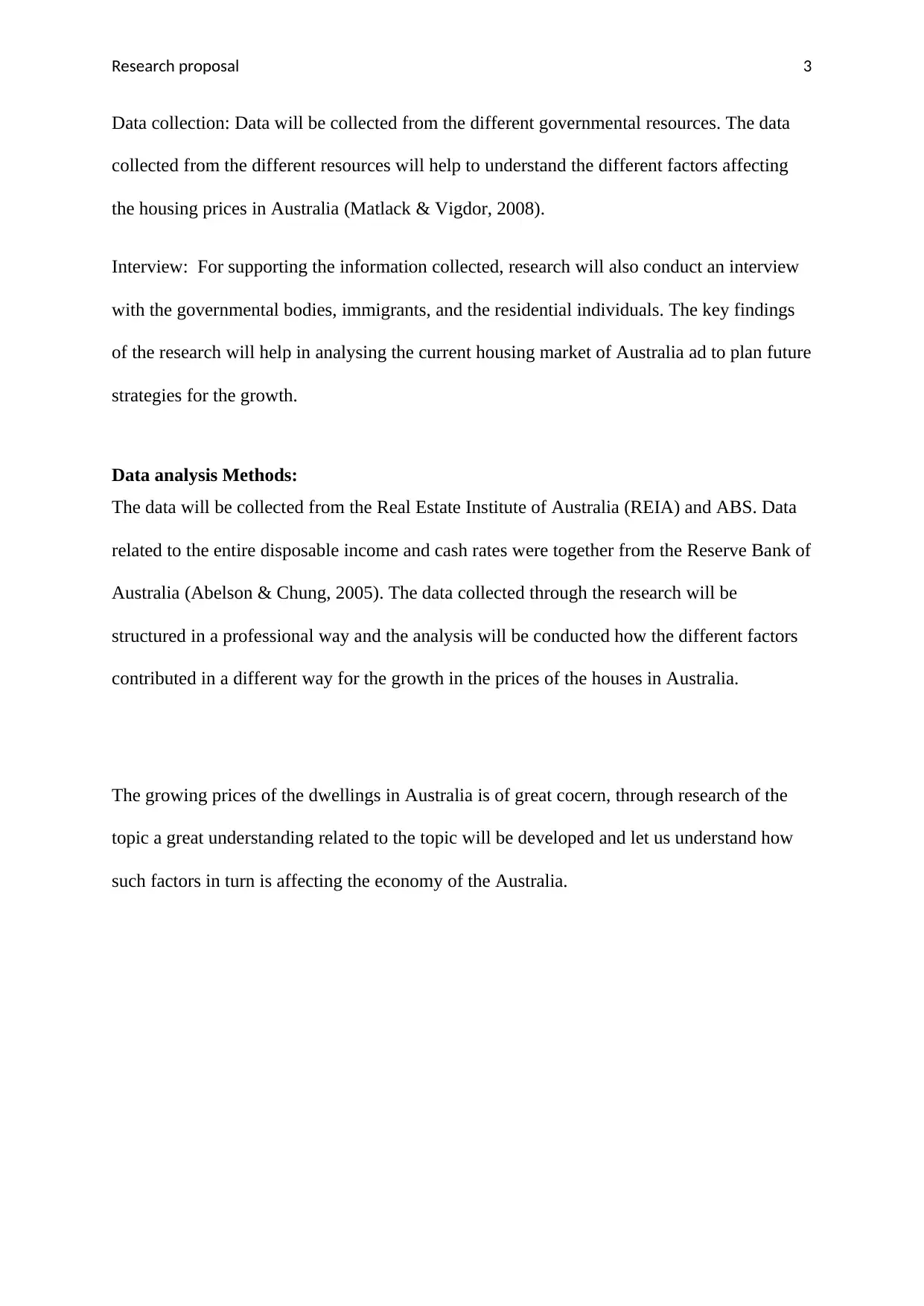
Research proposal 3
Data collection: Data will be collected from the different governmental resources. The data
collected from the different resources will help to understand the different factors affecting
the housing prices in Australia (Matlack & Vigdor, 2008).
Interview: For supporting the information collected, research will also conduct an interview
with the governmental bodies, immigrants, and the residential individuals. The key findings
of the research will help in analysing the current housing market of Australia ad to plan future
strategies for the growth.
Data analysis Methods:
The data will be collected from the Real Estate Institute of Australia (REIA) and ABS. Data
related to the entire disposable income and cash rates were together from the Reserve Bank of
Australia (Abelson & Chung, 2005). The data collected through the research will be
structured in a professional way and the analysis will be conducted how the different factors
contributed in a different way for the growth in the prices of the houses in Australia.
The growing prices of the dwellings in Australia is of great cocern, through research of the
topic a great understanding related to the topic will be developed and let us understand how
such factors in turn is affecting the economy of the Australia.
Data collection: Data will be collected from the different governmental resources. The data
collected from the different resources will help to understand the different factors affecting
the housing prices in Australia (Matlack & Vigdor, 2008).
Interview: For supporting the information collected, research will also conduct an interview
with the governmental bodies, immigrants, and the residential individuals. The key findings
of the research will help in analysing the current housing market of Australia ad to plan future
strategies for the growth.
Data analysis Methods:
The data will be collected from the Real Estate Institute of Australia (REIA) and ABS. Data
related to the entire disposable income and cash rates were together from the Reserve Bank of
Australia (Abelson & Chung, 2005). The data collected through the research will be
structured in a professional way and the analysis will be conducted how the different factors
contributed in a different way for the growth in the prices of the houses in Australia.
The growing prices of the dwellings in Australia is of great cocern, through research of the
topic a great understanding related to the topic will be developed and let us understand how
such factors in turn is affecting the economy of the Australia.
⊘ This is a preview!⊘
Do you want full access?
Subscribe today to unlock all pages.

Trusted by 1+ million students worldwide
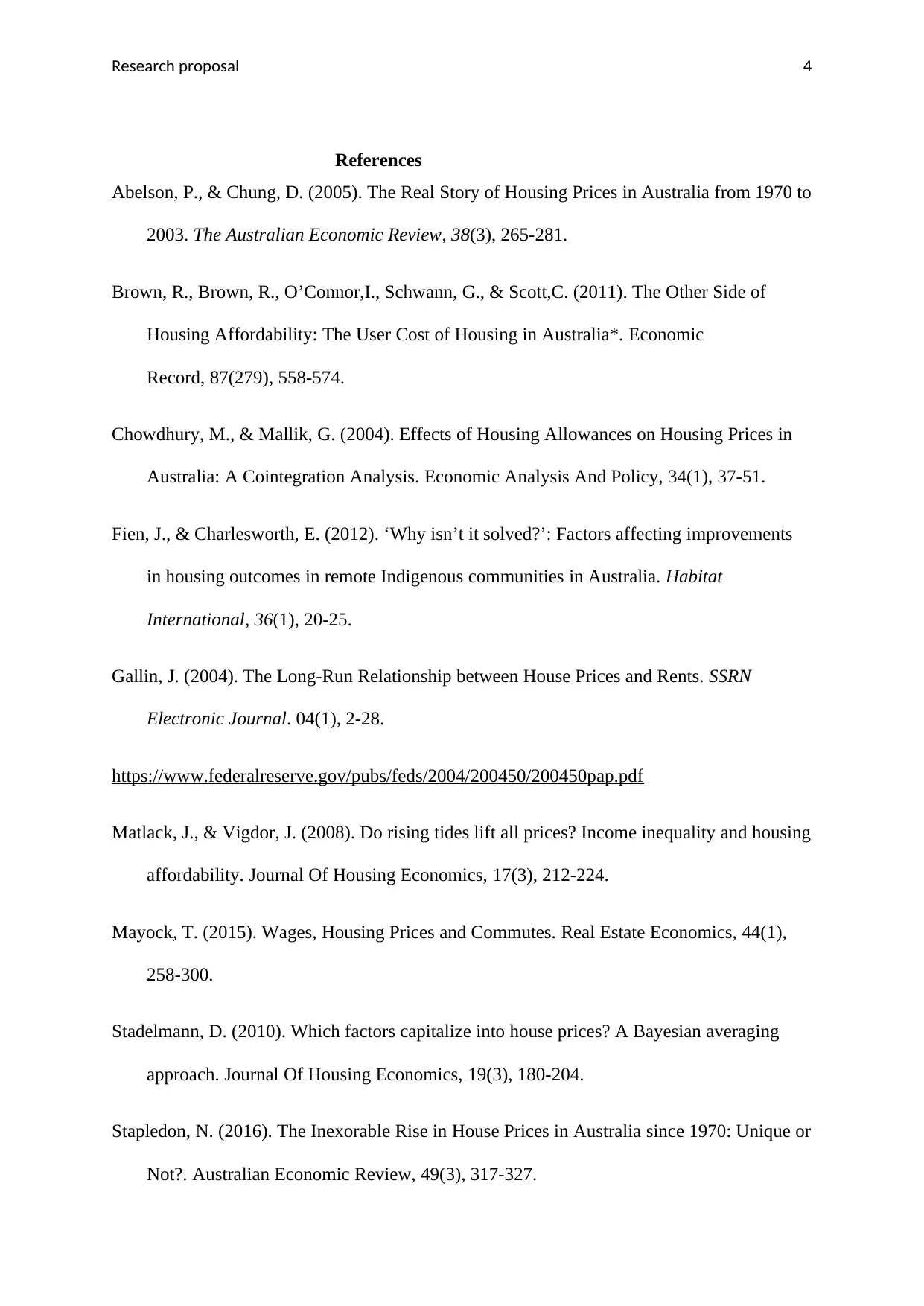
Research proposal 4
References
Abelson, P., & Chung, D. (2005). The Real Story of Housing Prices in Australia from 1970 to
2003. The Australian Economic Review, 38(3), 265-281.
Brown, R., Brown, R., O’Connor,I., Schwann, G., & Scott,C. (2011). The Other Side of
Housing Affordability: The User Cost of Housing in Australia*. Economic
Record, 87(279), 558-574.
Chowdhury, M., & Mallik, G. (2004). Effects of Housing Allowances on Housing Prices in
Australia: A Cointegration Analysis. Economic Analysis And Policy, 34(1), 37-51.
Fien, J., & Charlesworth, E. (2012). ‘Why isn’t it solved?’: Factors affecting improvements
in housing outcomes in remote Indigenous communities in Australia. Habitat
International, 36(1), 20-25.
Gallin, J. (2004). The Long-Run Relationship between House Prices and Rents. SSRN
Electronic Journal. 04(1), 2-28.
https://www.federalreserve.gov/pubs/feds/2004/200450/200450pap.pdf
Matlack, J., & Vigdor, J. (2008). Do rising tides lift all prices? Income inequality and housing
affordability. Journal Of Housing Economics, 17(3), 212-224.
Mayock, T. (2015). Wages, Housing Prices and Commutes. Real Estate Economics, 44(1),
258-300.
Stadelmann, D. (2010). Which factors capitalize into house prices? A Bayesian averaging
approach. Journal Of Housing Economics, 19(3), 180-204.
Stapledon, N. (2016). The Inexorable Rise in House Prices in Australia since 1970: Unique or
Not?. Australian Economic Review, 49(3), 317-327.
References
Abelson, P., & Chung, D. (2005). The Real Story of Housing Prices in Australia from 1970 to
2003. The Australian Economic Review, 38(3), 265-281.
Brown, R., Brown, R., O’Connor,I., Schwann, G., & Scott,C. (2011). The Other Side of
Housing Affordability: The User Cost of Housing in Australia*. Economic
Record, 87(279), 558-574.
Chowdhury, M., & Mallik, G. (2004). Effects of Housing Allowances on Housing Prices in
Australia: A Cointegration Analysis. Economic Analysis And Policy, 34(1), 37-51.
Fien, J., & Charlesworth, E. (2012). ‘Why isn’t it solved?’: Factors affecting improvements
in housing outcomes in remote Indigenous communities in Australia. Habitat
International, 36(1), 20-25.
Gallin, J. (2004). The Long-Run Relationship between House Prices and Rents. SSRN
Electronic Journal. 04(1), 2-28.
https://www.federalreserve.gov/pubs/feds/2004/200450/200450pap.pdf
Matlack, J., & Vigdor, J. (2008). Do rising tides lift all prices? Income inequality and housing
affordability. Journal Of Housing Economics, 17(3), 212-224.
Mayock, T. (2015). Wages, Housing Prices and Commutes. Real Estate Economics, 44(1),
258-300.
Stadelmann, D. (2010). Which factors capitalize into house prices? A Bayesian averaging
approach. Journal Of Housing Economics, 19(3), 180-204.
Stapledon, N. (2016). The Inexorable Rise in House Prices in Australia since 1970: Unique or
Not?. Australian Economic Review, 49(3), 317-327.
Paraphrase This Document
Need a fresh take? Get an instant paraphrase of this document with our AI Paraphraser
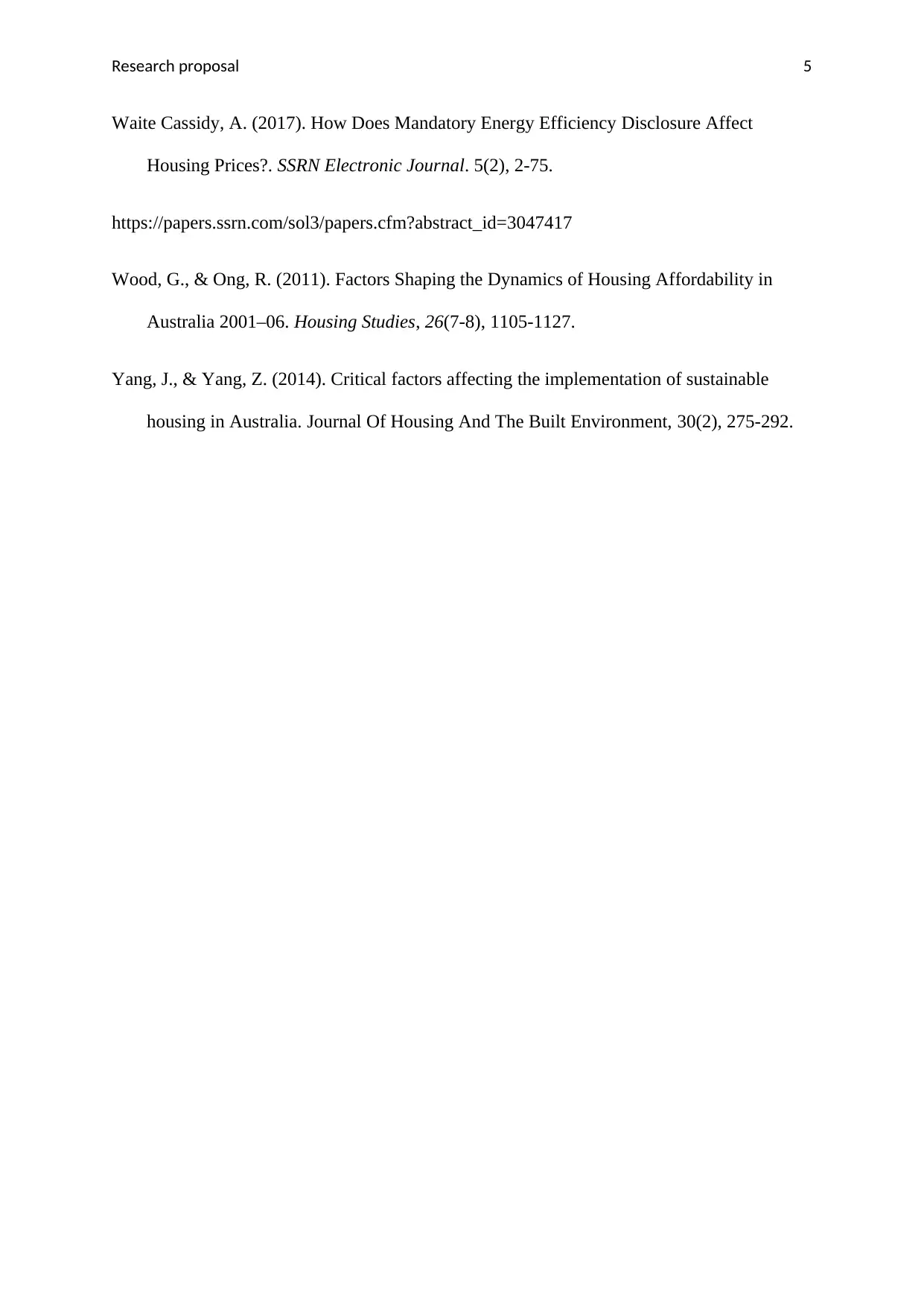
Research proposal 5
Waite Cassidy, A. (2017). How Does Mandatory Energy Efficiency Disclosure Affect
Housing Prices?. SSRN Electronic Journal. 5(2), 2-75.
https://papers.ssrn.com/sol3/papers.cfm?abstract_id=3047417
Wood, G., & Ong, R. (2011). Factors Shaping the Dynamics of Housing Affordability in
Australia 2001–06. Housing Studies, 26(7-8), 1105-1127.
Yang, J., & Yang, Z. (2014). Critical factors affecting the implementation of sustainable
housing in Australia. Journal Of Housing And The Built Environment, 30(2), 275-292.
Waite Cassidy, A. (2017). How Does Mandatory Energy Efficiency Disclosure Affect
Housing Prices?. SSRN Electronic Journal. 5(2), 2-75.
https://papers.ssrn.com/sol3/papers.cfm?abstract_id=3047417
Wood, G., & Ong, R. (2011). Factors Shaping the Dynamics of Housing Affordability in
Australia 2001–06. Housing Studies, 26(7-8), 1105-1127.
Yang, J., & Yang, Z. (2014). Critical factors affecting the implementation of sustainable
housing in Australia. Journal Of Housing And The Built Environment, 30(2), 275-292.
1 out of 5
Related Documents
Your All-in-One AI-Powered Toolkit for Academic Success.
+13062052269
info@desklib.com
Available 24*7 on WhatsApp / Email
![[object Object]](/_next/static/media/star-bottom.7253800d.svg)
Unlock your academic potential
Copyright © 2020–2025 A2Z Services. All Rights Reserved. Developed and managed by ZUCOL.





